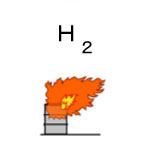| Case Name |
Leakage and fire of gas from lower piping of a heating furnace for start-up at an ammonia manufacturing plant |
| Pictograph |

|
| Date |
March 19, 1991 |
| Place |
Kawasaki, Kanagawa, Japan |
| Location |
Chemical factory |
| Overview |
An exothermic reaction progressed in a reactor with a heat recovery heat exchanger, and the reactor inlet temperature reached a reaction temperature. The cooling work started to stop the start-up heater. The cooling rate was too high, tightening force of the flange bolt became insufficient, and circulating gas leaked, and ignited. Another cause is that the scheduled tightening of bolts before starting cooling work might not be done. In addition, tightening force management for hot-bolting at starting operation that depended on skill and intuition seems also to be a cause. |
| Incident |
There was a fire at an ammonia synthesis plant. Start-up for the ammonia synthesis plant was done after turnaround shutdown maintenance finished. It was heated by a start-up heater until it reached a reaction temperature. An ammonia synthesis reaction began, and feed preheating became possible by heat of reaction only with a heat exchanger for heat recovery. Then, cooling work was carried out to stop the heating furnace. At that time, hydrogen rich gas (hydrogen 79%) leaked from the joint of the lower piping, and was ignited by a burner of the heating furnace. |
| Processing |
Manufacture |
| Individual Process |
Reaction |
| Chemical Reaction |
Other |
| Substance |
Hydrogen, Fig2 |
| Ammonia synthesis gas |
| Type of Accident |
Explosion, fire |
| Sequence |
On March 11th, 1991: The start-up heater exit piping was equipped.
On March 14th: An airtight test was carried out at 20 MPa.
On march 15th: The airtight test was continued at 33 MPa.
02:25 on March 19th: The start-up heater was ignited, and warming of the ammonia synthesis vessel started.
10:30: The ammonia synthesis reactor catalyst temperature reached a reaction temperature.
11:18: Source gas was introduced, and ammonia synthesis started.
About 13:25: Cooling of the start-up heater started. The heater outlet temperature at the start of cooling was about 400 °C.
14:25: An abnormal sound was made by the start-up heater. At this time, a fire was found at the lower part. The heater outlet temperature was about 305 °C. |
| Cause |
The cooling rate of the start-up heater during start-up work was high enough to lower bolt-tightening force of the flange. The cooling rate was about 100 °C for one hour shown by a graph in information source data. However, in the operating manual, it should be 50 °C/hr or less. In addition, the scheduled re-tightening at cooling work was not carried out during preparations. |
| Response |
An emergency shutdown. Urgent pressure reduction of the reaction system was done, and extinguishing by smothering was done with nitrogen filling. |
| Countermeasures |
1. The "work standard for tightening and re-tightening work at an outlet piping flange at start-up" was prepared, and thorough quantitative management of torque at bolt-tightening work was attempted.
2. The temperature is easy to control in cooling work. Concretely, by adding the fuel adjusting valve to the existing valve of 2-1/2 inches, with additional a 1 inch globe valve and a pressure gage, rate control at a temperature fall becomes easier. |
| Knowledge Comment |
1. Even at facilities with small operation frequencies, it is necessary to have a control system that suits the characteristics of the facilities.
2. It is important to change qualitative management to quantitative management, if possible. |
| Background |
Slipshod operational management is a basic problem, considering two items shown in the "Cause" column and that torque management for hot-bolting at start-up depended on experience and intuition.
Hot-bolting: Work to tighten a bolt when re-warming of high-temperature facilities is required by a temperature rise, as equipment and piping expand. Therefore, it is necessary to tighten equipment and bolts of piping at adequate temperature intervals. |
| Incidental Discussion |
The fuel requirement should have already decreased during cooling, and it was controlled by manual operation of the valve with allowances even under a full load. Probably, it is an operation that depends on a fingertip sense of an operator in almost completely closed conditions. The facilities were rarely operated and must be neglected. |
| Reason for Adding to DB |
Example of leakage and fire caused due to lack of rational control for not frequent start-up |
| Scenario |
| Primary Scenario
|
Poor Value Perception, Poor Safety Awareness, Inadequate Risk Recognition, Ignorance of Procedure, Disregard of Procedure, Excessive High Speed at Lowering Temperature, Planning and Design, Poor Planning, Repair Planning, Usage, Maintenance/Repair, Insufficient Tightening Force, Malfunction, Poor Hardware, Flange Leakage, Secondary Damage, External Damage, Leakage/Fire
|
|
| Sources |
Synthesis gas leakage, ignition from flange in S Co. K factory. Industry and protection, Vol.7, No.12, p.4(1991)
High Pressure Gas Safety Inst. of Japan, Ammonia production equipment, Gas leak, ignition at lower start-up heater. Accident examples of Petroleum refinery and Petrochemical units, pp.141-145(1995).
|
| Multimedia Files |
Fig2.Chemical formula
|
| Field |
Chemicals and Plants
|
| Author |
ARAI, Mitsuru (Environmental Science Center, The University of Tokyo)
TAMURA, Masamitsu (Center for Risk Management and Safety Sciences, Yokohama National University)
|
|